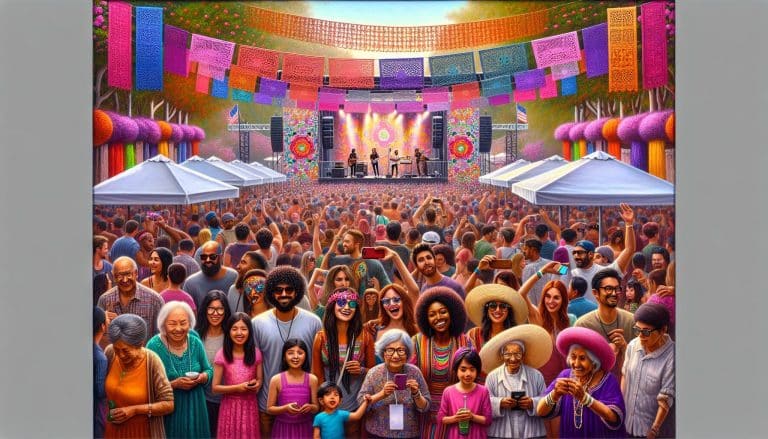When you’re starting out in festival production, there’s so much to know to execute your first festival successfully. Some of the terms used in the industry can be confusing, especially when many of them are shortened versions of the full term.
Here’s a head start so you’re not left scratching your head when having a conversation with a festival industry veteran or vendor:
Festival and Event Production Glossary
501c(3)
A provision in the U.S. tax code that grants tax-exempt status to nonprofit organizations, such as charities, religious groups, and educational institutions. These organizations don’t pay federal income tax and donors can deduct their contributions to these organizations on their tax returns.
53′ trailer
The most common length for semi-truck trailers in North America, often used for the transportation of equipment, supplies, and goods. It provides ample space for stage equipment, tents, and other festival gear.
aluminum rolls
Thin sheets of aluminum wound into rolls. In event production, they might be used for various purposes including wrapping cables, temporary repairs, or creating reflective surfaces.
amps (Amperes)
The unit of measure for electrical current. In event production, understanding the amperage needs is crucial to ensure that all equipment can operate safely without overloading the electrical supply.
apparent power
The combination of real power (measured in watts) and reactive power (measured in volt-amperes reactive or VARs) in an AC electrical system. It’s essential to consider when planning the electrical needs of an event.
automatic external defibrillator (AED)
A life-saving device used to treat sudden cardiac arrest by sending an electric shock to the heart. Having AEDs on-site at large events can be crucial for attendee safety.
back of house (BOH)
Refers to areas not visible to the public, such as staging areas, production tents, and areas where technical operations, dressing rooms, and storage might be located.
backend
In financial terms for artists and talent, the backend refers to the portion of earnings received after the event, often based on ticket sales or other revenue-sharing agreements.
bag checks
A security measure where attendees’ bags are inspected upon entry to ensure no prohibited items are brought into the venue.
bil-jax
A brand known for its staging and scaffolding equipment. Their products are often used to create stages, platforms, and other structures at events.
bill back
A process where one department or company charges another for services or goods. For example, a festival might bill back an artist for special equipment they requested.
bobtail
Refers to a semi-truck driving without its trailer attached. This can be during times when the trailer isn’t needed or when the truck is repositioning.
boneyard
A designated area at an event site where equipment, cases, or structures not currently in use are stored.
boom
An extendable arm, often found on cranes or microphone stands. In event production, booms allow for greater reach and flexibility in positioning equipment.
box trucks
Rectangular trucks used for transporting equipment. Unlike semi-trucks, they have a combined cab and cargo area, making them more maneuverable.
CAD (Computer-Aided Design)
Software tools used for designing and planning. In events, CAD might be used to design stage layouts, lighting plans, or site maps.
call time
The pre-scheduled time that crew, staff, or talent must report or “call” in for duty. It ensures that everyone is present and ready when needed.
camlock
A type of electrical connector designed for high-current applications. It’s often used for connecting large generators or power distribution systems at events.
carrying production
Refers to the equipment and resources an artist or performer brings with them for a show, as opposed to using local equipment.
cheeseborough
A versatile clamp used in rigging. It’s often used to attach truss pieces together or to secure equipment to trusses.
conduit
Protective tubing that houses electrical wires or cables. It’s used to ensure the safe routing of cables, especially in high-traffic areas or exposed outdoor settings.
contraband
Items that are illegal or not allowed in a venue. This can include drugs, weapons, or any item deemed a threat to the safety and enjoyment of the event.
Deads (or Deadweights)
Heavy weights used to provide stability to stage elements or structures, preventing them from moving or tipping.
direct box (DI box)
A device used to convert unbalanced and high-impedance instrument signals (like those from a guitar) to balanced and low-impedance signals suitable for direct input into a mixing console.
DMX (Digital Multiplex)
A communication protocol used for controlling stage lighting, effects machines, and other related equipment.
double time
A pay rate, usually twice the standard hourly rate, applied after a certain number of hours worked. It’s a way to compensate workers for long shifts or working unsociable hours.
duvetyne
A matte black, flame-resistant fabric often used in theatrical and film production for masking, draping, or blocking light.
edison outlets
Standard electrical outlets like those found in homes and offices. Named after Thomas Edison, they’re used for plugging in most standard electrical devices.
egress
Refers to the pathways or exits used to leave a venue or event space. Proper egress planning is essential for safety, ensuring attendees can exit quickly in case of emergencies.
emergency action plan
A detailed plan that outlines the steps to be taken in various emergency situations, from severe weather to security threats.
emergency response plan
Similar to the emergency action plan, this details the specific responses and actions for different emergencies, often focusing on immediate actions and first responders.
expendable
Items expected to be used up during the course of an event. This might include things like tape, batteries, or other consumables.
flow-through barricade
A crowd control barrier designed to allow controlled movement of people through certain points, ensuring crowd safety while maintaining order.
fluff and fold
Refers to laundry services, often provided for performers or talent during multi-day events.
FOH (Front of House)
This can refer to two things: the public area of a venue (as opposed to behind-the-scenes areas) or the location within an audience space where sound and lighting engineers operate.
frequency sweep
A method of testing audio systems by playing back frequencies across the audible spectrum (from low to high) to ensure even sound reproduction and identify potential issues.
gaff tape (or gaffer’s tape)
A durable, adhesive tape widely used in theaters and film/TV production. It’s strong, leaves no residue, and is easily torn by hand.
gel
Thin, colored sheets used to change the color of lights in theatrical productions. They’re placed in front of light sources to produce different lighting effects.
glamping (Glamorous Camping)
Camping that includes luxuries and amenities not typically associated with traditional camping. At festivals, this might involve upscale tents, bedding, and other comforts.
gooseneck
A flexible, often metal, arm or tubing. In production, it’s frequently seen in microphone stands or lamps, allowing for precise positioning.
greywater
Wastewater that doesn’t contain serious contaminants. It comes from sources like sinks and showers, and can sometimes be recycled for uses like irrigation.
guest services
Services and amenities provided for attendees, such as information booths, lost and found, or accessibility services.
heavy equipment
Large machinery, such as cranes, forklifts, or bulldozers, used for major tasks in setting up or tearing down event sites.
IEMs (In-Ear Monitors)
Earphones used by performers to hear a mix of stage audio. They allow artists to hear themselves and other performers clearly, regardless of ambient stage noise.
IMAG (Image Magnification)
The use of large video screens to display live camera feeds of a performance, allowing attendees further from the stage to see the action clearly.
ingress
The entrance or means of entering a venue. Proper ingress planning ensures smooth flow of attendees into an event without long waits or bottlenecks.
IP 65
An Ingress Protection rating indicating that equipment is dust-tight and can withstand water jets. This rating is vital for outdoor events to ensure equipment safety.
jib
A type of camera crane with an arm that can swing, providing sweeping shots. Often used at larger events to capture dynamic video footage.
kilowatt-hour (kWh)
A measure of electrical energy equivalent to a power consumption of one kilowatt for one hour. It’s a unit commonly seen on electricity bills.
line array
A configuration of loudspeakers in a line, often hung vertically in front of the stage. They provide consistent sound coverage over a wide area.
load-in
The process of moving equipment and supplies into a venue in preparation for an event.
load-out
The process of moving equipment and supplies out of a venue after an event has concluded.
loading dock
A raised platform where trucks or vans can park to load and unload goods and equipment. Essential for larger venues or events with significant equipment needs.
lull
A type of telehandler or telescopic forklift. It’s often used in event production to lift and move heavy equipment or materials.
mags (magazines)
In the context of film or old-school photography, these are storage units for film. However, in a broader context, it can also refer to periodicals or other publications.
media
Journalists, photographers, and other representatives from media organizations who cover the event. They often have specific access and areas designated for them.
merch (merchandise)
Goods, often branded, sold at events. This can include t-shirts, posters, albums, and other memorabilia.
minute by minute
A highly detailed event schedule, breaking down activities by minute. It’s used for precise coordination and timing of event elements.
overtime
Hours worked beyond a regular work schedule. In many countries or industries, these hours are compensated at a higher rate than regular hours.
P & L (Profit and Loss)
A financial statement summarizing revenues, costs, and expenses during a specific period. It provides a clear picture of financial performance.
passboards
Boards or displays that show the various credentials and their associated access levels. Helps staff and security quickly identify who can access certain areas.
pat downs
A manual, physical search by security to ensure attendees aren’t carrying prohibited items. It’s a more thorough check than just visual inspection or bag checks.
per advance
Refers to the pre-event communications and planning process. Production teams “advance” the show by discussing technical needs, schedules, and other details before arrival.
petty cash
A small reserve of cash kept on hand for immediate, minor expenses. It’s used when formal purchasing processes aren’t practical.
pink noise
A type of noise with equal energy per octave, making it sound balanced to the human ear. It’s often used in audio testing to tune systems.
portalet
Another term for portable toilets, often used at outdoor events or venues without sufficient permanent restroom facilities.
post event report
A comprehensive report generated after an event detailing what occurred, feedback, financial details, and other relevant information. It’s used for analysis and planning future events.
potable
Water that is safe for humans to drink. At events, ensuring a supply of potable water is crucial, especially in hot or remote locations.
quad box
An electrical box with multiple outlets, typically four. It allows multiple devices to be plugged in from one power source.
quartermaster
Originally a military term, in event contexts, it’s the person responsible for equipment and supplies, ensuring everything is in its place and available when needed.
rachet strap
A type of strong strap with a ratcheting mechanism, used to secure equipment during transport. It allows for tight, secure fastening.
radios
Handheld communication devices used by event staff to coordinate in real-time. Essential for large events or venues to ensure smooth operations.
radius clause
A provision in performance contracts that prevents artists from performing in nearby locations within a certain time frame, ensuring exclusivity for the event.
reactive power
In electrical systems, it’s the power stored in and discharged by inductive and capacitive components. While it doesn’t do “useful” work like turning a motor or lighting a bulb, it’s essential for maintaining voltage levels in a power system.
reefer truck
A refrigerated truck used to transport perishable goods, like food or certain equipment that needs to be kept cool.
repeater
In radio communication, a repeater captures, amplifies, and re-transmits signals to extend their range.
RF (Radio Frequency)
Electromagnetic wave frequencies used for wireless communications. In events, this often relates to microphones, in-ear monitors, and communication devices.
RFID (Radio-Frequency Identification)
A technology where data encoded in RFID tags is captured by a reader via radio waves. Used at events for things like access control or tracking.
rowpack
Cases or containers designed for easy transport and storage. They’re often tailored to fit specific equipment or supplies.
scaff (scaffolding)
Temporary structures made of metal poles and planks, used to support workers and materials. In events, they can be used for building stages, lighting rigs, or camera platforms.
sea container
Large, standardized shipping containers used to transport goods by sea. They can be used at events for storage or even as makeshift structures.
shop fork
A specialized type of forklift used in warehouses or shops for moving and lifting equipment.
snake
In audio, a snake is a bundled group of cables, often combining multiple audio channels into one larger cable for easier routing.
spider box
A type of power distribution unit that takes a single power input and distributes it to multiple outlets. Useful for events needing power in multiple locations.
sundries
Miscellaneous small items or goods that don’t fit into main categories. In event production, this might include minor tools, accessories, or supplies.
swag
Derived from “stuff we all get”, it refers to promotional items given away for free, often branded with an event or company logo.
tails
The ends of electrical cables, often used to connect to generators or other power sources.
true power
The actual power consumed by equipment to do useful work, measured in watts.
turnkey
Refers to solutions or services that are ready to use immediately upon delivery or implementation. In events, a turnkey booth, for example, would be one that’s fully set up and ready for use upon arrival.
visqueen
A brand of polyethylene plastic sheeting, often used in construction or events as a waterproof cover or barrier.
VOG (Voice of God)
An unseen announcer who makes official announcements at an event, typically over the PA system.
voltage
A measure of electric potential difference between two points. It’s essential to know when setting up electrical systems to ensure compatibility and safety.
volunteers
Individuals who offer their services without seeking compensation. Many events rely on volunteers for various roles, from ticket checking to stage setup.
wands
Handheld metal detectors used by security personnel to check attendees for prohibited metal items.
watts
The unit of power in the International System of Units. It quantifies the rate of energy transfer.
white noise
A sound that contains every frequency within the range of human hearing in equal amounts. In audio testing, it’s used to check equipment across all frequencies.
XLR cable
A type of audio cable known for its balanced signals and three pins. It’s commonly used for microphones and high-quality audio equipment.



